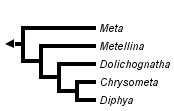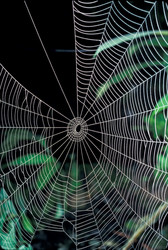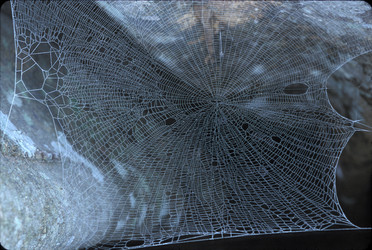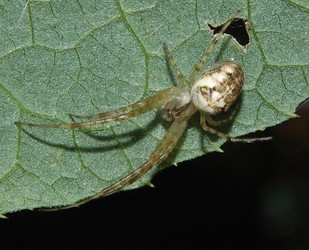Metainae
Dimitar Dimitrov and Gustavo Hormiga


This tree diagram shows the relationships between several groups of organisms.
The root of the current tree connects the organisms featured in this tree to their containing group and the rest of the Tree of Life. The basal branching point in the tree represents the ancestor of the other groups in the tree. This ancestor diversified over time into several descendent subgroups, which are represented as internal nodes and terminal taxa to the right.

You can click on the root to travel down the Tree of Life all the way to the root of all Life, and you can click on the names of descendent subgroups to travel up the Tree of Life all the way to individual species.
For more information on ToL tree formatting, please see Interpreting the Tree or Classification. To learn more about phylogenetic trees, please visit our Phylogenetic Biology pages.
close boxIntroduction
Metainae includes the genera Meta, Metellina, Dolichognatha, Chrysometa and Diphya (Álvarez-Padilla et al., 2009). Taxonomically, this group has proved to be the most unstable lineage within the family, and its composition has changed, sometimes considerably, across different phylogenetic analyses. Simon (1894) used the name Metinae for a group of similar composition.
Characteristics
Metaines are distinguished from other tetragnathids by the well sclerotized spermathecae and fertilization ducts; the short copulatory ducts (shorter than half the spermathecae length, which in some taxa, such as Meta menardi, are almost non existent); the wide separation of the spermathecae (more than two spermatheca diameters); and an ecto-basal cymbial process shaped as a cuticular flat outgrowth (this process can be massive in some species). All Metainae have just a single embolic apophysis, known as the "metine embolic apophysis." Similar embolic apophyses are also found in Cyrtognatha and Allende.



Left: Web of Chrysometa alajuela. Right: Web of Dolichognatha. Images © 2006 Gustavo Hormiga
Metainae build a diversity of orbwebs. In some species, like Dolichognatha (shown on the right picture), the webs are horizontal and very dense (i.e., with many spiral turns and radii, including secondary radii). Meta species, such as M. menardi, build rather flimsy orbs, with few radii and spiral turns, despite the large size of these animals. Members of the large Neotropical genus Chrysometa build vertical orb webs with two sectors missing the sticky spiral turns and with a "telegraph line" running from the hub to a retreat.
Discussion of Phylogenetic Relationships
The Metainae cladogram presented here is based on the morphological and molecular analysis of Álvarez-Padilla at al. (2009). Metainae are more closely related to the Nanometa clade and Leucaugines than to Tetragnathinae. However, the limits of the Metainae remain unclear, as the composition of this lineage is very unstable and sensitive to different data treatments. At present this subfamily includes the genera Meta, Metellina, Dolichognatha, Chrysometa and Diphya.
References
Álvarez-Padilla F., Dimitrov D., Giribet G., Hormiga G. 2009. Phylogenetic relationships of the spider family Tetragnathidae (Araneae, Araneoidea) based on morphological and DNA sequence data. Cladistics (In press).
Simon E. 1894. Histoire naturelle des araignées. Paris, 1: 489-760.
Title Illustrations

| Scientific Name | Metellina segmentata |
|---|---|
| Location | Berlin, Grunewald, Germany |
| Specimen Condition | Live Specimen |
| Identified By | K.-H. Kielhorn, Berlin |
| Source | File:Metellina_segmentata_070820.jpg |
| Source Collection | Wikimedia Commons |
| Image Use |
 This media file is licensed under the Creative Commons Attribution-ShareAlike License - Version 3.0. This media file is licensed under the Creative Commons Attribution-ShareAlike License - Version 3.0.
|
| Copyright | © Rainer Altenkamp, Berlin |
About This Page
Dimitar Dimitrov

Zoological Museum, University of Copenhagen
Gustavo Hormiga

George Washington University, Washington, D. C., USA
Correspondence regarding this page should be directed to Dimitar Dimitrov at and Gustavo Hormiga at
Page copyright © 2009 Dimitar Dimitrov and Gustavo Hormiga
 Page: Tree of Life
Metainae.
Authored by
Dimitar Dimitrov and Gustavo Hormiga.
The TEXT of this page is licensed under the
Creative Commons Attribution-NonCommercial License - Version 3.0. Note that images and other media
featured on this page are each governed by their own license, and they may or may not be available
for reuse. Click on an image or a media link to access the media data window, which provides the
relevant licensing information. For the general terms and conditions of ToL material reuse and
redistribution, please see the Tree of Life Copyright
Policies.
Page: Tree of Life
Metainae.
Authored by
Dimitar Dimitrov and Gustavo Hormiga.
The TEXT of this page is licensed under the
Creative Commons Attribution-NonCommercial License - Version 3.0. Note that images and other media
featured on this page are each governed by their own license, and they may or may not be available
for reuse. Click on an image or a media link to access the media data window, which provides the
relevant licensing information. For the general terms and conditions of ToL material reuse and
redistribution, please see the Tree of Life Copyright
Policies.
- First online 09 March 2009
- Content changed 09 March 2009
Citing this page:
Dimitrov, Dimitar and Gustavo Hormiga. 2009. Metainae. Version 09 March 2009 (under construction). http://tolweb.org/Metainae/134627/2009.03.09 in The Tree of Life Web Project, http://tolweb.org/







 Go to quick links
Go to quick search
Go to navigation for this section of the ToL site
Go to detailed links for the ToL site
Go to quick links
Go to quick search
Go to navigation for this section of the ToL site
Go to detailed links for the ToL site